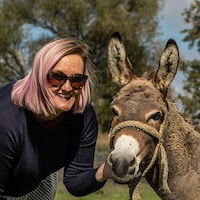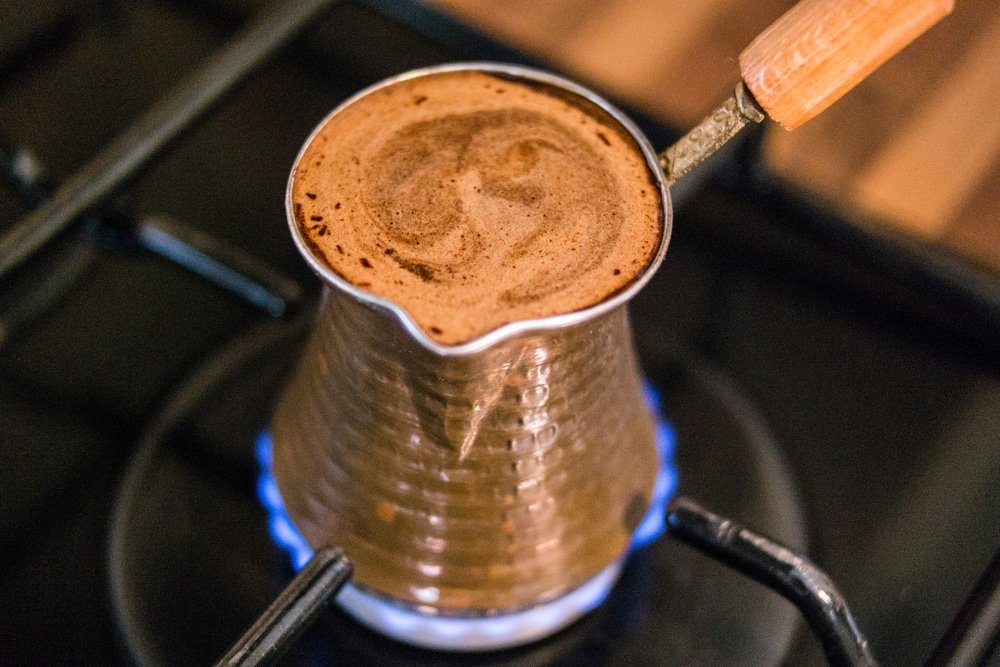Making Turkish coffee at home is like taking a quick trip to the vibrant streets of Istanbul with every sip. I find the process meditative, and the result is always a small, potent cup of tradition that’s heavy on flavor. I will show you just how easy it is to make it at your place.
I love that you don’t need a fancy machine or an electricity source—just a cezve (a special Turkish coffee pot, though any small pot will do), some water, coffee that’s ground to a fine powder, and a heat source. If you like your coffee with a little sweetness or spice, sugar, cardamom, or even cinnamon can come into play.

For me, the key to perfect Turkish coffee is in the technique, and once you’ve got that down, it’s a straightforward process you’ll want to repeat.
It all starts with the right ratio of water to coffee—typically, a heaping tablespoon for every small cup of water. This isn’t your average morning joe; it’s a robust brew that packs a punch, both in flavor and in ritual.
The magic is in the foam—golden crema that tells you you’ve hit the jackpot in terms of temperature and patience.
When you start making Turkish coffee, patience is not just a virtue; it’s essential. Rush the brew, and it won’t taste as good.
Keep the heat low and let the water warm gently to coax out the flavors.
Each step, from measuring to the final pour, is a chance to personalize your cup.
Whether you’re a seasoned aficionado or a curious newbie, brewing Turkish coffee at home is an art worth mastering. It’s a slice of culture served up right in your kitchen.
Skip Ahead To My Advice Here!
Origin & History Of Turkish Coffee
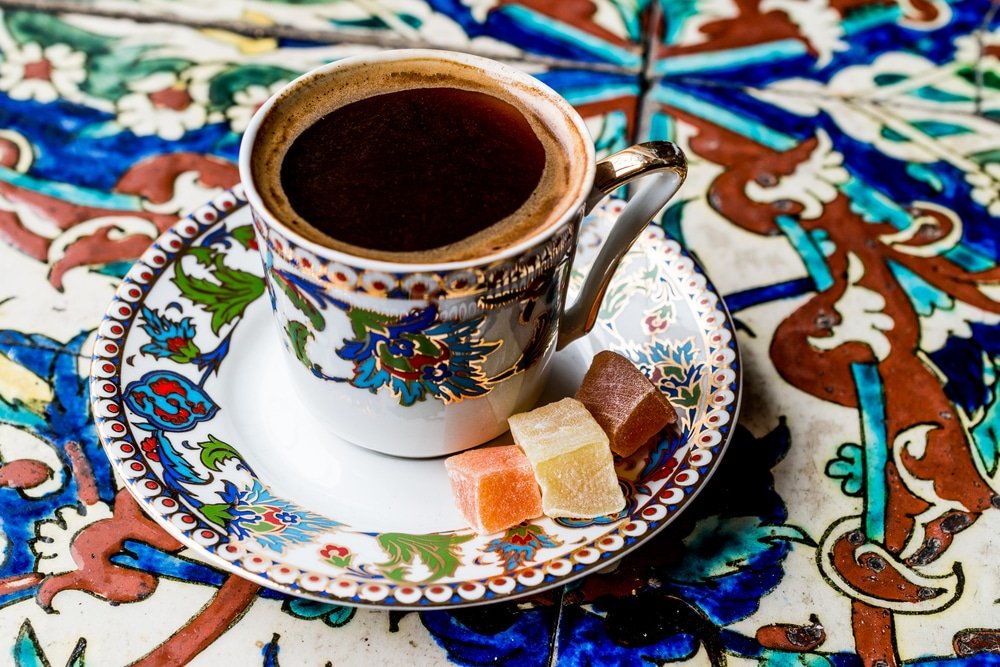
Making Turkish coffee is more than a daily routine; it’s an enduring tradition that I find utterly captivating. This method of coffee preparation originated in the Ottoman Empire—in the 1500s, it was all the rage in Istanbul, and swiftly, the buzz spread far and wide, infusing itself into Turkish culture as a symbol of hospitality and friendship.
Here’s the scoop.
- Serving. Traditionally, when Turks serve you Turkish coffee, it’s a gesture of warmth. It’s not just handing over a cup of joe but an invitation to slow down and savor the moment. That’s why you’ll often find it served with water to cleanse the palate and something sweet on the side, like a piece of Turkish delight or a date
- Social. Gatherings resonate with the sounds of lively conversation and the clinking of coffee cups. It’s a social adhesive, really. When I sit down with friends to sip Turkish coffee, it’s customary to linger and chat, enjoying each other’s company. Politics, soccer, the weather—it’s all on the table.
- Fortune-telling. And if you think the fun stops when the coffee’s gone, you’re in for a surprise. With the grounds left in the cup, I’ve seen fortunes told by flipping the cup over onto the saucer. It’s a quirky, fascinating bit of entertainment that gets everyone laughing and guessing.
In every sip I take, I taste centuries of tradition distilled into a uniquely potent brew. Turkish coffee isn’t just a drink; it’s a slice of cultural heritage, served up one aromatic cup at a time. If you’re like me, appreciating the story behind the steam might just make your next cup all the more enjoyable.
Brands We Use And Trust
Essential Turkish Coffee Ingredients
To master a cup of traditional Turkish coffee, it’s crucial to select the right ingredients. From the specific coffee grind to the water quality, each component plays a vital role in crafting an authentic experience.
Coffee Beans And Grind
The foundation of Turkish coffee is an ultra-fine grind, finer than espresso, that’s powdery in texture. Typically, Arabica beans are chosen for their superior flavor and aroma. I ensure my beans are freshly ground, which makes a notable difference in taste. When buying pre-ground, I look for Turkish grind specifically labeled on the package.
Water Quality
Water is a silent ingredient that affects the final outcome of the coffee. I use cold, filtered water to avoid any impurities or chlorine tastes that could affect the subtle flavors of the coffee grounds. It’s this attention to detail that lets the true coffee flavors shine through.
Sugar And Spices
The addition of sugar and spices is optional but can transform the coffee’s profile. I adjust sugar to taste, adding it into the cezve before heating to ensure the perfect blend of coffee and sugar. For spices, cardamom is a classic, but cinnamon and cloves can also be used to infuse the brew with additional layers of flavor. It’s these customizations that make Turkish coffee a personal and unique experience from whoever makes it.
I like my coffee without sugar, but 90% of my guests ask for a little sugar, so I suggest you start with 1/2 a teaspoon per cup to start with.
Equipment To Make Traditional Turkish Coffee
When I make Turkish coffee at home, I use a few key pieces of equipment to ensure that my brew is authentic and delicious. Here’s what you’ll need to gather before you get started.
Cezve – Turkish Coffee Pot
This is the traditional Turkish coffee pot, typically made of copper or brass. It has a wide bottom, a narrower neck, and a long handle. Using a cezve helps the brewing process. But, before I owned one, or if I am making coffee for a lot of guests, I used a regular stainless steel long-handled pot – so you can use that to start with.
Heat Source
An even and controllable heat source is crucial. At home, I usually use my stovetop. Nevertheless, you can use an electric burner, gas top, or sand heated by a flame if you want to make it like the real Turkish coffee vendors.
Turkish Coffee Cups – But You Can You ANY You Own

A cup of coffee in Turkey is traditionally served in demitasse cups, which are small, often decorative cups that hold the perfect amount of coffee. They help in preserving the temperature and the thick foam of the coffee. You can use whatever you have at home; like your espresso cups, after all, it does not change the taste.
Optional Accessories To Make Coffee
- Coffee Grinder. To achieve the extra-fine grind required for Turkish coffee, a grinder capable of producing a powder-like consistency is a handy accessory
- Coffee Spoon. A small spoon is helpful for mixing and transferring the coffee into the cezve
- Serving Tray. To carry and present the coffee traditionally and elegantly
Recipe For How To Make Turkish Coffee At Home
Making Turkish coffee is a tradition steeped in history, and it’s easier than you might think to recreate this rich, aromatic beverage at home. Here’s my Turkish coffee recipe.
Equipment Needed
- A cezve (Turkish coffee pot)
- A heat source
- Demitasse cups
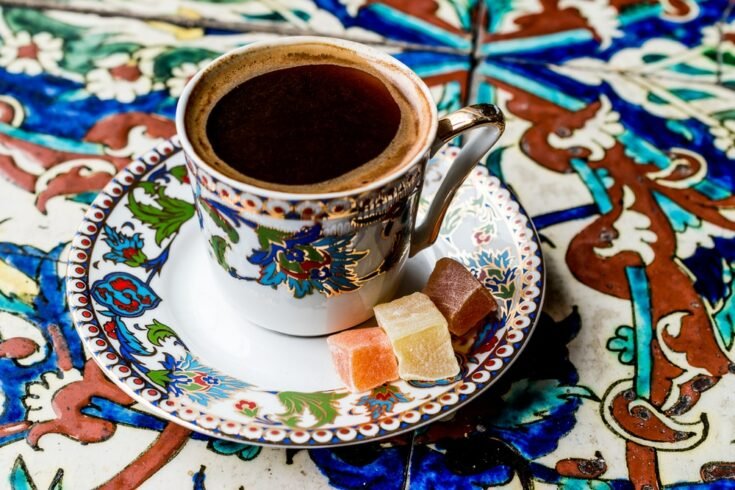
How To Make Turkish Coffee At Home
Ingredients
- Fine Turkish coffee grounds - 1 tablespoon per cup of coffee
- Cold water - 4 ounces (120 mls) per cup of coffee
- Sugar - optional see * below
- Cardamom pod - optional
Instructions
- To perfect your Turkish coffee-making technique, begin by determining how many cups you'd like to brew and use a corresponding amount of cold water. Measure the water for each cup you're planning to make and pour it into your cezve, a traditional Turkish coffee pot. This pot should then be placed on a heat source, ready for the next steps
- Next, incorporate a heaping tablespoon of finely ground Turkish coffee for every cup into the cezve. Remember, the grind should be fine to achieve the authentic texture. If you prefer your coffee with sugar, now is the time to add it according to your taste preference (see the note below)
- Stir the mixture gently to ensure the coffee and sugar (if added) are thoroughly mixed with the water, aiming to prevent the coffee from settling at the bottom. Place the cezve over a low to medium heat and let the coffee brew slowly. Watch carefully as a foam begins to form on the surface
- As soon as the foam rises to the cezve's rim, remove it from the heat briefly to let the foam subside. You'll need to repeat this step a few times—typically 2-3—to fully develop the coffee's flavor through successive brewing
- After the final brewing, remove the cezve from the heat and allow it to rest momentarily. This pause lets the coffee grounds settle at the bottom of the pot
- Then, carefully pour the coffee into small cups, ensuring the sediment remains undisturbed and the foam is neatly transferred on top
- To round off the serving experience, present the Turkish coffee with a piece of traditional Turkish delight or a glass of water.
Notes
*Sugar note: Traditionally, Turkish coffee is served in three different levels of sweetness: sade (no sugar), az şekerli (a little sweet), and çok şekerli (very sweet).
Brewing Turkish Coffee
Making Turkish coffee is a unique process that differs from other brewing methods due to its fine grounds and the absence of filtering. Let’s dive into the steps that bring out its distinctive flavor and make it foamy.
Proportioning Ingredients
For a classic cup of Turkish coffee, I measure about one heaping tablespoon of ground coffee – remember it has to be finely ground per four ounces (120 ml) of water. If my friends and family prefer their coffee sweet, adding sugar at this stage is crucial. The amount varies on taste, but a common guideline is one teaspoon per cup – but you make it to your preference.
Blending Coffee And Water
I combine the coffee and cold water in a cezve — a traditional Turkish coffee pot with a wide bottom, a narrow neck, and a long handle. If I’m adding sugar, I mix it in now. A brief stir ensures everything is evenly combined.
Heating Process
Now, I slowly heat the cezve on the stovetop over low to medium heat. This is not a rush job — the low and slow approach is vital. It should take approximately 3-4 minutes on the stove for the coffee to start warming up and eventually approach a simmer. Repeat several times.
Monitoring The Foam
The magic of Turkish coffee is in the foam, so I keep my eyes peeled. As the coffee heats, a dark foam builds up. Right before it reaches boiling point and the foam is about to rise, I remove the cezve from the heat. I might skim off some foam into my cup before returning the pot to heat and repeating this process a couple of times to increase the foam. If you do not watch it – you will have a huge black mess to clean up.
Serving Turkish Coffee
After mastering the art of brewing a perfect cup of Turkish coffee, the next step is to serve it with the grace and tradition it deserves. Serving is not just a mere act but a respectful presentation that enhances the coffee experience.
Tradition Of Serving
In Turkish culture, coffee is more than just a beverage; it’s a ritual that has deep roots in hospitality and social tradition. The eldest guest is typically served first as a sign of respect. Coffee is poured into the cups without stirring to ensure the grounds stay at the bottom of the pot, preserving the coffee’s strength and flavor. The cup is then offered with the handle pointing toward the recipient, allowing them to enjoy the rich crema.
Presentation Tips
To truly honor the ritual of serving Turkish coffee, you’ll want to pay attention to a few key presentation tips.
- Cups. Traditionally, Turkish coffee is served in small porcelain cups, which help to keep the coffee hot and maintain the froth
- Tray. Serve the coffee on a decorative tray for a touch of elegance
- Water. It is customary to offer a glass of water with the coffee to cleanse the palate beforehand
- Sugar. If sugar is to be added, it should be done during the brewing process, not after serving. Stirring in sugar afterward would disrupt this sediment, altering the intended experience of enjoying Turkish coffee
Accompaniments
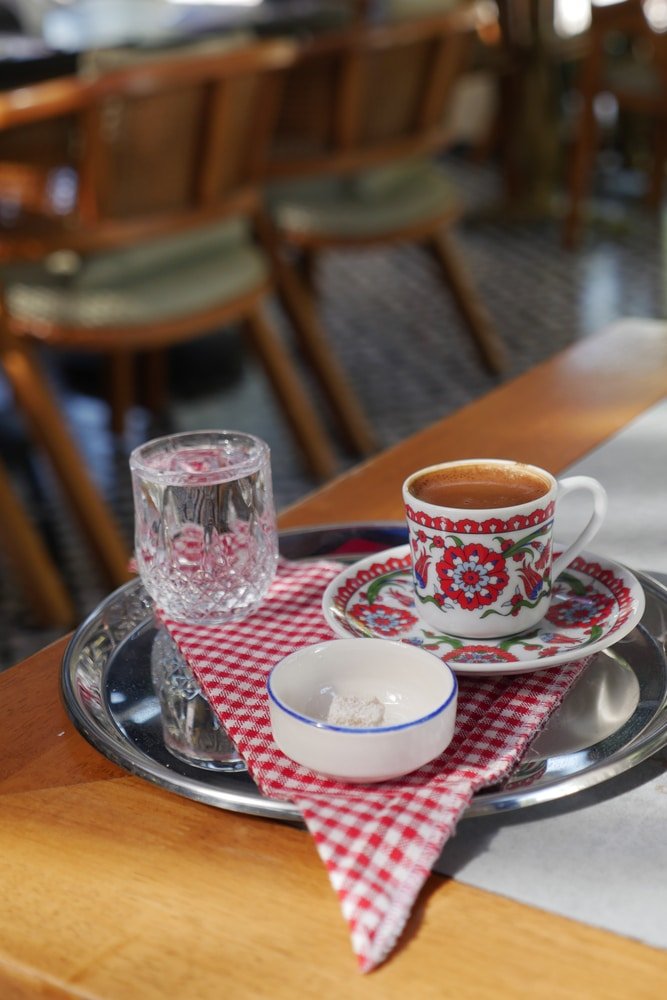
Turkish coffee is often accompanied by small sweets that complement the strong, rich flavor of the coffee. The most common offerings include.
- Turkish Delight (Lokum). A chewy, small sweet treat dusted with icing sugar or coconut flakes
- Chocolate. A piece of dark chocolate can balance the coffee’s robust taste
- Nuts. Roasted nuts like pistachios or almonds are a great palate cleanser
- Water. Always serve with a glass of water
Move This Adventure To Your Inbox & Get An Instant Freebie

No spam. Unsubscribe at any time.
Cleaning And Maintenance
Maintaining my Turkish coffee equipment ensures that every cup I brew is as delicious as the last. Routine care prevents buildup in the coffee pot called a cezve and preserves the integrity of the coffee’s flavor.
Caring For The Cezve
My cezve is essential for making Turkish coffee, so I keep it in tip-top shape. Here’s how.
- After each use. I rinse it with warm water and a gentle sponge
- Soap. That isn’t necessary and can actually harm the metal
- For tougher stains. A mixture of water, baking soda, and a soft cloth does the trick, while vinegar can help remove any tarnish
- Dry thoroughly. I always dry my cezve immediately to prevent rust or water spots
Grinder And Cups Care
My grinder and cups are just as important, so here’s how I care for them.
- Weekly deep clean. I disassemble the grinder to clean individual parts, ensuring no old grounds are left to stale
- Daily cleaning. I wipe my grinder with a dry cloth daily to avoid oil buildup from the beans
Grinder Part Cleaning Method Blades/Burrs Brush out leftover grounds. Hopper Wipe with a damp cloth as needed.
Final Word On How Turkish Coffee Is Made
Alright, let’s wrap this up real quick. You’ve got the lowdown on how to whip up Turkish coffee right in your kitchen—no frills, no fuss, just straight-up good brew that embodies Turkish cuisine.
Grab your cezve or ibrik, toss in the water and Turkish coffee, and remember, it’s 1 spoon per cup to keep it legit. Like your coffee sweet? Throw in the sugar early; we’re not making instant coffee here.
The grind? Think super fine, almost like you’re plotting to take over the espresso grind game. Now, heat it slowly; watch for that foam, but don’t let it boil over.
Once you’ve got that golden foam on top, you’re in business. Pour it out carefully; aim to keep a bit of that foam for each cup because that’s the good stuff.
And hey, Turkish coffee ain’t just a drink, it’s an experience—thick, aromatic, and straight from the heart of the Middle East. So next time you’re brewing, think of it as a mini-vacay to Istanbul, no passport needed. Cheers to your next home coffee adventure!

